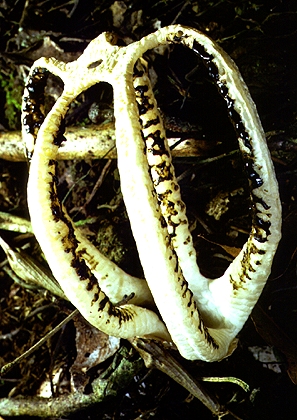
Pseudocolus fusiformis (E.Fisch.) Lloyd

Common name: None.
Description: The fungus emerges from a white, soft, gelatinous egg about 13 cm in diameter and forms a basket or cage-like ball up to 10 cm in diameter. The specimens depicted here are white; however, there is also a red form. There are no interconnecting arms that form a lattice work (as in Colus hirudinosus) and the 45 arms usually remain connected at their summit. The olive, slimy, foetid spore mass is found on the inner surface of the arms.
The spores measure 35 × 12 µm, are narrowly ellipsoidal to cylindrical, smooth and colourless.
Substratum: Pseudocolus fusiformis occurs on rich soil and leaf litter or humus in sheltered locations in subtropical and tropical rainforest. It is usually solitary, but small groups of two or three may be encountered.
Distribution: Known from Queensland and New South Wales.
Notes: The foetid odour of the spore-carrying slime is highly attractive to blow flies which feed on it and carry the spores off on their feet. The specimen shown here varies from the typical Pseudocolus fusiformis by the colour. There are other closely related species of Pseudocolus which are white (P. garciae from Brazil, and P. brownii from the Philippines). Not enough is known about these species to be certain if the Australian Pseudocolus fusiformis is distinct. For the moment, the Australian species is treated as distinct.
